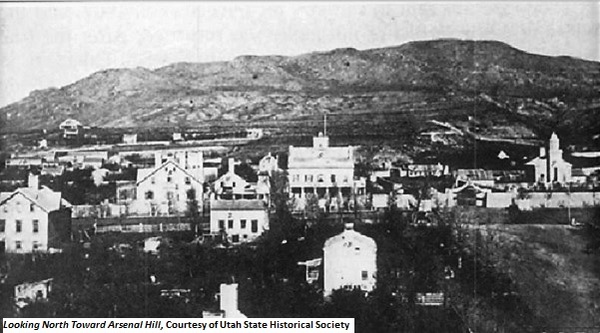Dublin Core
Title
Description
An explosion rocked Salt Lake City in 1876, killing four people.
In 1876, as Utahns were converging on Salt Lake City eager to attend the LDS Church’s general conference, a powerful blast rocked the northern part the city, shattering windows, demolishing buildings, and sending people scurrying for cover. Some city residents, angered by the persistent presence of federal troops in Utah, thought the explosion was the work of Commanders at Fort Douglas, who, they surmised, had issued an order to bombard the city and exterminate the Mormons.
Only when things had finally quieted down and crowds began fanning out to investigate the blast was the true source of the destruction discovered. Climbing Arsenal Hill (now Capitol Hill) in search of an explanation for the explosion, curious onlookers found that the powder magazines that once crowned the hill had detonated leaving only a few craters. Observers also witnessed something far more grisly. Strewn about the hill were scraps of clothing and human remains, some up to a half-mile from the site of the blast. According to historical sources, the deaths of four people were blamed on the explosion. The bodies of two teenage boys, Charles Richardson and Frank Hill, were never found. Three-year-old Joseph Raddon was cut down when a rock ripped through his chest. And a pregnant women named Mary Jane Van Natta was felled by a flying boulder. Other stories of the Arsenal Hill incident included hair-raising accounts of rocks hurtling through houses, sometimes smashing into just-vacated rooms and tables.
An investigation of the tragedy concluded that the explosions were caused by a burning wad from a gun, perhaps fired by victim Charles Richardson who had taken a gun with him to Arsenal Hill. According to a troop of boys who had been playing baseball near the magazine that day, a small cluster of young men had been hanging around the magazines shooting at flocks of geese in the area.
In the end, close to 500 tons of rock and other debris had rained down on Salt Lake as a result of the explosions. Leaders of the LDS Church still held conference, though nearly a thousand panes of glass on the north face of the Tabernacle had shattered, forcing them to have the holes covered with cloth. According to historian Melvin Bashore, the destruction was so widespread that a Civil War veteran exclaimed that Salt Lake looked worse that the city of Fredericksburg, Virginia, after several days of artillery bombardment.
Creator
Source
Image: Looking North toward Arsenal Hill. Once can see the arsenal at the extreme upper left. Courtesy of Utah State Historical Society.
_______________
See news reports about the Arsenal Hill explosion in the April 6 and April 7, 1876, editions of the Salt Lake Tribune. Also see Melvin L Bashore, “The Arsenal Hill Explosion,” Utah Historical Quarterly 52 (Summer 1984): 246-255; and Linda Sillitoe, A History of Salt Lake County (Salt Lake City: Utah State Historical Society and Salt Lake County Commission, 1996), 87-90.

